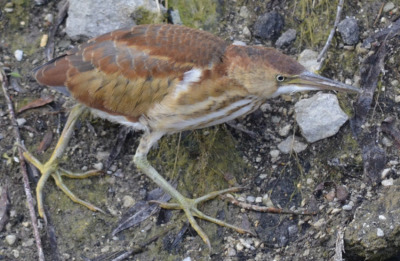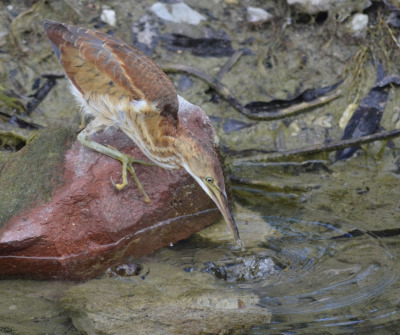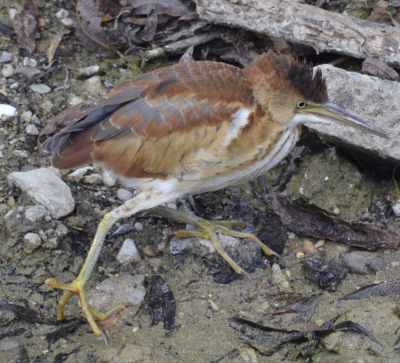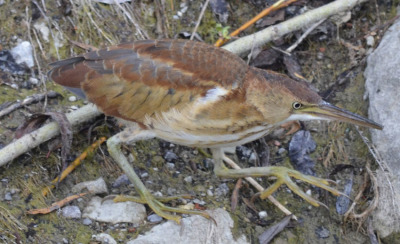In September, 2014, I read online that a young Least Bittern was visiting a small marshy area along the marina harbour at Colonel Sam Smith park in Toronto so I went looking for it.
Small Bird Swarmed by Masses of 2-Legged Creatures Carrying 3-Legged Sticks
I quickly learned the fastest ways to find the Least Bittern were to
- look for a crowd of people with tripods and astonishingly large lenses on cameras; and/or
- listen for a flurry of mechanical clicks, ticks and whirrs as shutters exploded into action whenever the diminutive bird moved
In fact there were so many photographers jostling for a shot of this elusive quarry that the first two times I visited the park I didn’t even try to take a photo. I just stayed in the back, watching for a few minutes in case the bird departed over night.
How Unusual Is a Least Bittern?
I knew seeing any Bittern was unusual. They are secretive birds and their favourite habitat is deep among the rushes and cattails where they blend in beautifully. In fact, most reports I’ve read of Bitterns come from people who have heard them calling rather than seen them hunting.
It wasn’t until after I started researching a bit that I found that Least Bitterns may be even more rare. They are currently listed as “threatened” both provincially in Ontario and nationally in Canada. They are therefore protected by the Endangered Species Act. According to the ROM website, no one is entirely certain how at risk they are; It is hard to know how common they used to be due to their preference for secluded swamps.
Still, it was interesting to read that the Act “prohibits any activities…i.e. harassing….” I wonder if the bird considered the paparazzi of photographers harassment?
I’m not sure it did. For at least three weeks, the bird continued to hunt along an essentially open stretch of canal while dogged every step by at least one photographer. It could and did repeatedly catch prey while only 2 metres (or fewer) away from excited photographers trying to freeze frame the action.
How Does a Juvenile Least Bittern Differ from an Adult?
According to AllAboutBirds, an adult Least Bittern is “black or darkish brown” on the crown of the head and the back, with a warm orange-brown colour on the neck and sides.
The juvenile, it says, has a paler and browner crown.
The one we were watching had very little darkness on its back yet.
When fully grown, the bird is still quite small. It’s almost the same size as a grackle and only about 2/3 the size of a Crow. A Least Bittern is about 30 cm, or a foot, long. Many people expected a larger bird, including me!, because a Bittern is quite a bit bigger.
The Least Bittern Dance
Several times, I got to observe a funny behaviour that’s reported in many camouflage birds. The Least Bittern used a slow repetitive movement presumably to make it look more like the vegetation it is coloured to resemble. In one particular case, though, the bird was perched on a rock, not in the rushes, so the rhythmic movement of its body did not look like reeds swaying in the wind. Instead it looked like a slow dance move. Unfortunately, I wasn’t able to take any video of it to share.
I was very pleased to see this small bird and I hope it safely passes the winter and starts its own family next year. I wouldn’t mind seeing more of them around!
Related Reading
Join In
Did you join the masses of birders admiring the Least Bittern this fall? Did it worry you to see so many photographers documenting its every move? Please share your experiences with a comment.




